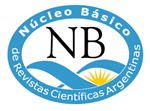Los fundamentos de la visualidad de la justicia: antecedentes y origen de su tipología iconográfica en el Medievo
Resumen
Palabras clave
Texto completo:
PDFReferencias
Santo Tomás de AQUINO, Suma Teológica, Madrid, Editorial Católica, 1955-1960, vol. 8.
ARISTÓTELES, Ética nicomáquea; Ética eudemia, Madrid, Gredos, 1985.
AUTORA, La visualidad de las Virtudes Cardinales, València, Universitat de València, Tesis doctoral inédita, 2019.
Bartolomeo di BARTOLI, La Canzone delle Virtù e delle Scienze, Bérgamo, Ed. d’Arti Grafiche, 1904.
Juan CARMONA, Iconografía clásica: guía básica para estudiantes, Madrid, Istmo, 2002.
Gregoria CAVERO, “Imágenes reales, imágenes de justicia en la catedral de León”, E-Spania: Revue électronique d'études hispaniques médiévales, 2007, 3. En: https://journals.openedition.org/e-spania/204 (10/2/2020).
Marco Tulio CICERÓN, Los oficios, Buenos Aires, Espasa-Calpe, 1946.
Marco Tulio CICERÓN, Retórica a Herenio, Barcelona, Bosch, 1991.
Marco Tulio CICERÓN, La invención retórica, Madrid, Gredos, 1997.
María Teresa CRUZ YÁBAR y Rogelio PÉREZ BUSTAMANTE, Iustitia: la justicia en las artes, Madrid, Comunidad de Madrid, 2007.
Samuel Y. EDGERTON, “Icons of justice”, Past and Present: A Journal of Historical Studies, 1980, 89, p. 23-38.
Miguel Ángel ELVIRA, Arte y mito: manual de iconografía clásica, Madrid, Sílex, 2008.
Juan F. ESTEBAN, Tratado de iconografía, Madrid, Istmo, 1990.
Eva FROJMOVIC, “Giotto’s allegories of Justice and the Commune in the Palazzo della Ragione in Padua: a reconstruction”, Journal of the Warburg and Courtauld Institutes, 1996, 59 pp. 24-47.
Rafael GARCÍA MAHÍQUES, Empresas morales de Juan de Borja. Imagen y palabra para una iconología, València, Ajuntament de València, 1998.
Rafael GARCÍA MAHÍQUES, Iconografía e Iconología. Cuestiones de método, Madrid, Encuentro, 2009.
Bono GIAMBONI, Il libro de' vizî e delle virtudi e Il trattato di virtú e di vizî, Turín, G. Einaudi, 1968.
Ernst GOMBRICH, Imágenes simbólicas, Madrid, Debate, 2001.
José María GONZÁLEZ GARCÍA, J.M., The eyes of justice: blindfolds and farsightedness, vision and blindness in the aesthetics of the law, Vittorio Klostermann, Frankfurt am Main, 2017.
Christine HARRAUER, Diccionario de mitología griega y romana: con referencias sobre la influencia de los temas y motivos antiguos en las artes plásticas, la literatura y la música de Occidente hasta la actualidad, Barcelona, Herder, 2008.
HESÍODO, Obras y fragmentos: Teogonía. Trabajos y Días. Escudo. Fragmentos, Madrid, Gredos, 1997.
Colum HOURIHANE, Virtue & vice: the personifications in the Index of Christian art, Press, Princeton N.J., Index of Christian Art, Dept. of Art and Archaeology, Princeton University in association with Princeton University 2000.
Adolf KATZENELLENBOGEN, Allegories of the virtues and vices in mediaeval art: from early christian times to the thirteenth century, Nendeln, Liechtenstein, Kraus Reprint, 1939.
Douglas P. LACKEY, “Giotto in Padua: A New Geography of the Human Soul”, J Ethics. The Journal of Ethics: An International Philosophical Review, 2005, 9, 3-4, pp. 551-572.
Ambrosio Teodosio MACROBIO, Comentario al “Sueño de Escipión” de Cicerón, Madrid, Gredos, 2006.
Émile MÂLE, L'art religieux de la fin du moyen age en France: étude sur l'iconographie du moyen age et sur ses sources d'inspiration, París, Armand Collin, 1925.
Raimond van MARLE, Iconographie de l'art profane au Moyen-Age et à la Renaissance et la décoration des demeures, Nueva York, Hacker Art Books, 1971, vol. 2.
José Luis MORALES, Diccionario de términos artísticos, Zaragoza, Edelvives, 1985.
Cary J. NEDERMANN, “The Opposite of Love: Royal Virtue, Economic Properity, and Popular Discontent in Fourteen-Century Political Thought”, en István P. BEJCZY y Cary J. NEDERMANN (eds.), Princely virtues in the Middle Ages, 1200-1500, Turnhout, Abingdon, Brepols, 2007, pp. 177-201.
Helen F. NORTH, From myth to icon: reflections of Greek doctrine in literatura and art, Ithaca NY, Cornell university Press, 1979.
John ONIANS, Bearers of meaning: the classical orders in antiquity, the Middle Ages, and the Renaissance, Princeton N.J., Princeton University Press, 1988.
Jennifer O’REILLY, Studies in the iconography of the virtues and vices in the Middle Ages, Nueva York, Garland Pub., 1988.
Eduardo PALLARES, Diccionario de Derecho Procesal Civil, Méjico, Porrúa, 1983.
Miguel PERIAGO LORENTE (ed.), Himnos órficos, Madrid, Gredos, 1987.
PLATÓN, La República, Madrid, Instituto de Estudios Políticos, 1949.
PLATÓN, Las leyes, Madrid, Instituto de Estudios Políticos,1960.
Daude de PRADAS, Four cardinal virtues, Florencia, A. Würtenberger, 1879.
Adriano PROSPERI, Justice blindolded: the historical course of an image, Leiden, Brill, 2018.
Louis RÉAU, Iconografía del Arte Cristiano, Barcelona, Serbal, 2000.
Judith RESNIK, “Representing Justice: From Renaissance Iconography to Twenty-First-Century Courthouses”, Proceedings of the American Philosophical Society, 2007, 151, 2, pp. 139-183.
Judith RESNIK y Dennis CURTIS, Representing Justice: Invention, Controversy, and Rights in City-States and Democratic Courtrooms, New Haven, Yale University Press, 2011.
María Isabel RODRÍGUEZ LÓPEZ, “Iconografía de la Justicia en las artes plásticas (desde la antigüedad hasta las postrimerías del Medioevo)”, Saberes, 2003, pp. 1-26.
Sara SÁNCHEZ PRIETO, “El espejo de la justicia: acercamiento a sus principales símbolos e imágenes”, Lex Nova: La Revista, 2010, 59, pp. 40-41.
Santiago SEBASTIÁN, Iconografía medieval, Donostia, Etor, 1988.
Quentin SKINNER, “Ambroggio Lorenzetti on the power and glory of republics”, en Quentin SKINNER, Visions of politics, Cambridge, Cambridge University Press, 2002, pp. 93-117.
Randolf STARN y Loren PATRIDGE, L., Arts of Power: Three Halls of State in Italy, 1300-1600, Berkeley, University of California Press, 1992.
Guy de TERVARENT, Atributos y símbolos en el arte profano: diccionario de un lenguaje perdido, Barcelona, Ediciones del Serbal, 2002.
Shawn R. TUCKER, The Virtues and Vices in the Arts, Cambridge, The Lutterworth Press, 2015.
Marina ZAMORA, Las virtudes del príncipe: la exaltación del monarca moderno en El gran carrro triunfal de Maximiliano I, Albacete, Universidad de Castilla la Mancha, 2014.
Enlaces refback
- No hay ningún enlace refback.
Copyright (c) 2021 Cuadernos Medievales

Este obra está bajo una licencia de Creative Commons Reconocimiento-NoComercial-SinObraDerivada 4.0 Internacional.
















